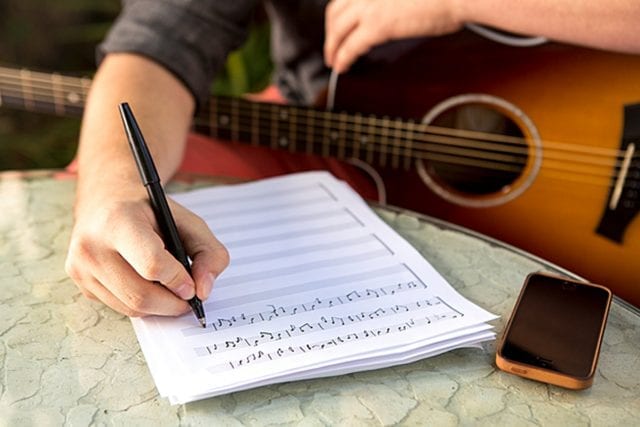
Making songs for a living is viable in today’s time as your options for a career are endless. Even if you aren’t an artist and not looking for a musical career, you can still make brilliant music to pitch to TV producers and commercials that will allow you to make more than enough revenue to make a good living.
But to get there, you need to actually make a song and the process is rather complicated, to say the least. Making songs takes a lot of time and hard work, but we’ve got a few tips that will help hasten the process of song making.
This is merely one approach that we will talk about, and no doubt there are numerous others, so sit back and let’s get started with the song making process.
First, the Lyrics

1. Start With the Title of Your Song
The most important part of the song is the title itself. Much like a video thumbnail, a songs’ title is what will draw the attention of your listeners. Furthermore, the title will give you something to start on and something to build on.
The title of your song should be the part that will give you the idea of the rest of the song. Most music artists use titles with up to six words, and the phrase itself should be something that will sum up the song itself.
To start with it, you can always go something that has deep emotions to you. You can also look into your past and for key moments that define you who you are. Many music artists tell their story through their music, and it is something that has been proven to work.
2. Create a Structure for Your Song
A song structure is no doubt the thing that will define it. Many of today’s big hits employ a simple, but highly effective, structure that goes along the lines of verse – chorus – verse- chorus – bridge – chorus. There have been found other variations of this format, but it hasn’t been proven to be as effective as it.

Various artists also include a “pre-chorus” section after the verse and the beginning of the chorus for the simple reason to build anticipation and momentum coming into the verse. The chorus and verses should be different in a way that your listeners can identify which is which, and it’s also important because your listeners will instantly recognize your song.
3. Focus More on the Verses and Chorus
The chorus can make or break your song. Truly, the chorus is the part that people will mostly recognize from your song. So to make the most out of it, you need to think harder for it. The chorus can easily be created if you simply ask a question and have the answer in it.
Simply write down the question, and start writing down the answers to it. Look for images or feelings that will give life to the answer. Think about which emotions you’re feeling, and how to describe them in your song.
The Beat, Melody, and Chords

4. Find the Rhythm
Your song needs a beat, melody, and chords otherwise no one will listen to your song. Now that you have your chorus and verses, it’s now time to find the natural rhythm and melody that will go perfectly with it. For some artists, this is the hardest part, as not everyone is an expert in beat making. The easiest way to do this is to sing your song out loud and look for those natural emotions in your verses and chorus.
This will put you on a good path to creating a beat that will go nicely with your lyrics. You can also skip this part and find a beat that you like to use in your song.
There are plenty of royalty-free beats on the internet that require nothing but to include the author in your song bio. This is something that everyone does and its how the music industry works for beginners. One such royalty-free website that has beats for every musical genre is freebeats.io.
5. Finish off With the Chorus Melody
Most artists have two separate melodies for their verses and their chorus. This is not something unusual and it’s even considered best practice. However, you don’t need to use a completely new beat for it, you can always find patterns in your existing beat to come up with something different for the chorus.
Separate those chords and play around with it. Having a beat that goes nicely with your chorus can b the difference-maker in most cases. Once you do find something interesting to work with, grab your smartphone and record yourself singing to it.
Finishing Touches

6. Work on the Verses
Now that you have everything from lyrics to rhythm, it’s now time to do some work to perfect them. Everything that you did until this part is considered a work in progress. Your song isn’t made yet, and you still have some work to do. Namely, the verses should always be connected to another.
The first verse of your song should be something that will grab the listeners’ attention, while the second verse should give more information. You could use an interesting argument, a question, even a description of a certain situation in your first verse, and offer a further explanation to it in the second.
7. Connect the Verses With the Chorus
Now that you’ve got fully fit verses, it’s time to do some work on the chorus. To do this, you need to somehow create a connection first between the verses and your chorus. You can easily do this by repeating the previous step and have the chorus complement the verses.
We mentioned the structure of a song, so chances are you’re going to have two choruses. The thing previously mentioned should solely focus on your first chorus, while you should have the second chorus complimented by a bridge.
The bridge section, however, is the part of your song that is the realization. It is the part that makes people go “ahaa” and it should be nothing more than two to three lines.








